StarTech USB 3.0 Docking Station for Two Laptops
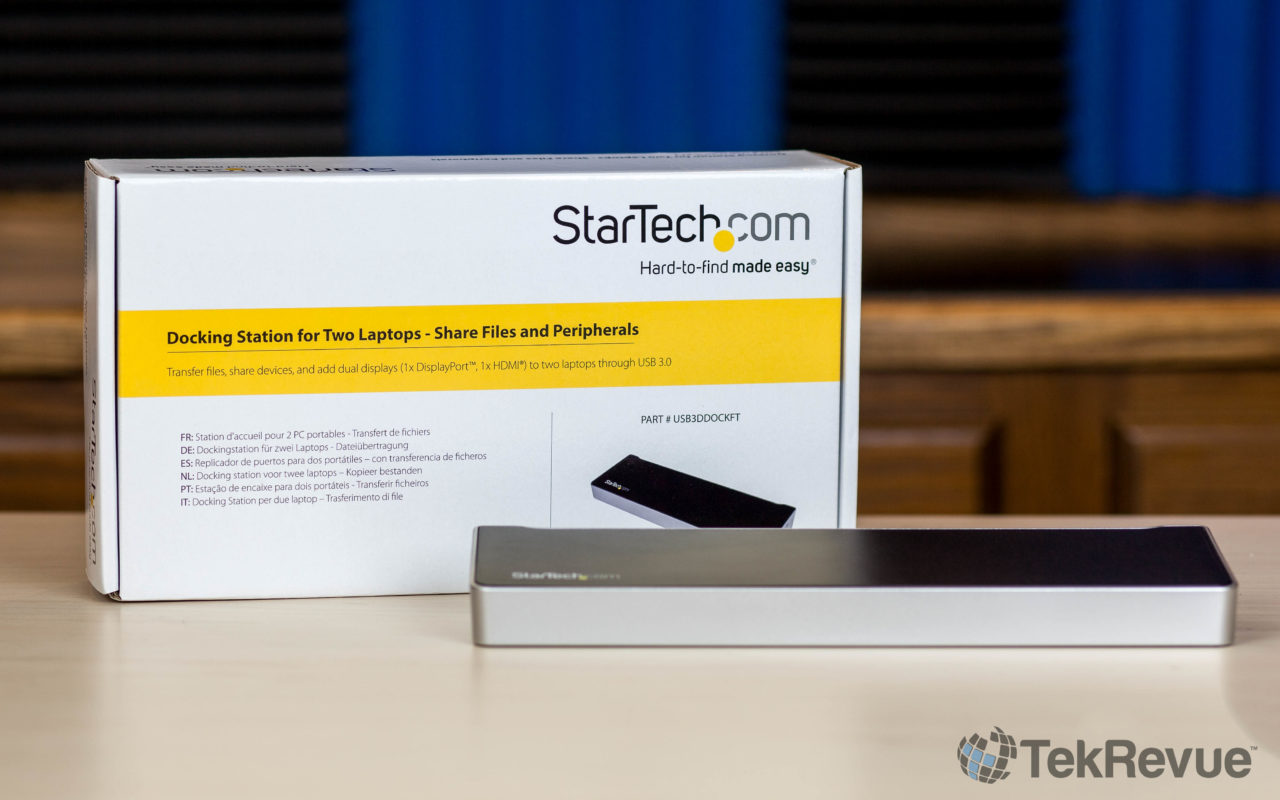
Laptop docking stations are an increasingly important segment of the computing market, allowing users to quickly and easily bridge the gap between an ultra-portable mobile experience and a more traditional desktop experience with multiple large displays, external hard drives, speakers, and other peripherals. We’ve looked at a number of docking stations in the past, most built around Thunderbolt technology. Today, we have something a bit different, both in terms of its connectivity technology and its capabilities: the StarTech Docking Station for Two Laptops.
Unlike the StarTech Thunderbolt 2 Dock, which we reviewed earlier this year, the Docking Station for Two Laptops uses USB 3.0 to make its connection to the host computer. USB 3.0 has a lower maximum bandwidth (5Gbps) compared to Thunderbolt (10Gbps) and Thunderbolt 2 (20Gbps), but it makes the docking station available to a much larger range of PCs and Macs. This lower bandwidth limit does have its disadvantages, however, which we’ll discuss later on.
Beyond the use of USB 3.0, the Docking Station for Two Laptops has another unique feature, which you’ve probably already guessed from its name: it supports two laptops (technically two computers, as it will work with desktops, too) simultaneously, allowing a user to share certain resources – displays, USB storage, speakers, and a single keyboard and mouse – between two separate systems.
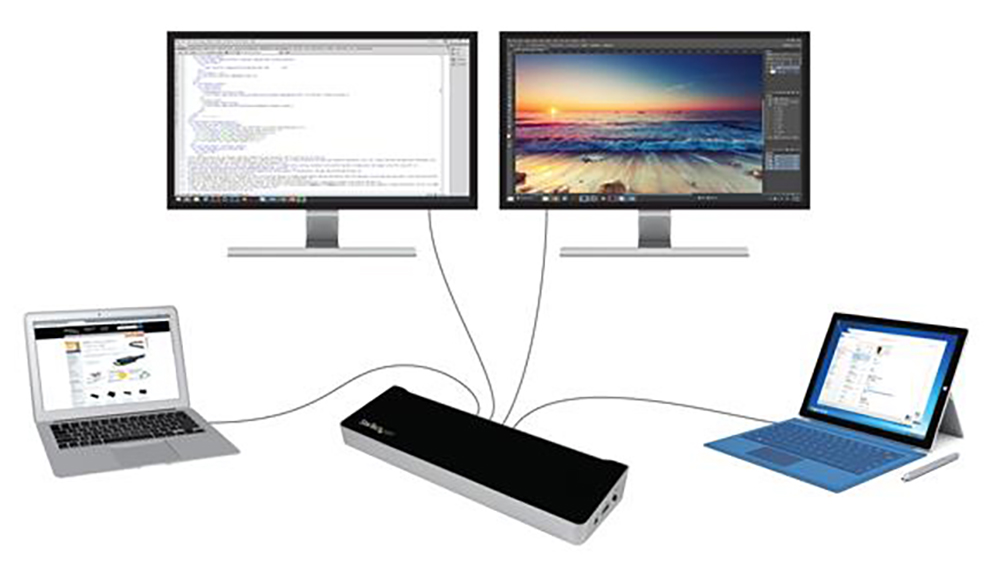
This unique feature is ideal for shared working environments or for those who, like us, have multiple PC and Mac laptops but don’t want to set up separate workstations for each. When properly configured, two laptops can share up to two external displays, five USB 3.0 devices including keyboards and mice, a set of external speakers, and a wired gigabit Ethernet port. There’s also the ability to directly transfer files between two connected laptops at USB 3.0 speeds.
The key phrase in the paragraph above, however, is “properly configured.” Unlike many of the Thunderbolt-based docking stations we’ve looked at, the Docking Station for Two Laptops is not “plug and play.” Some features such as basic USB hub functionality will indeed work out of the box, but the use of direct file sharing and external displays requires the installation of additional software and drivers. The file sharing software, PCLinq5, is included on a shared volume that’s accessible from the docking station itself when a compatible PC or Mac is connected, and users can pick up the drivers needed for the display functionality from StarTech’s website.
Design & Build Quality
Turning to the docking station itself, users will find an attractive device with a black and silver color scheme. But don’t let the silver color fool you; the docking station’s exterior shell is all plastic, which gives it a very lightweight design but lacks the heft and refinement of StarTech’s aluminum-clad Thunderbolt 2 Dock.
Even with a plastic shell, however, the docking station feels sturdy and well built, with sharp lines, smooth edges, and solid ports that didn’t wiggle or move during our testing, as we’ve seen on some cheaper devices.
Rubber feet keep the docking station positioned safely on your desk, and its low profile design (10.6 inches long by just 1.3 inches tall) should allow it to easily fit into any desktop setup. The StarTech Docking Station for Two Laptops isn’t the most attractive design we’ve seen in a desktop docking station, but it’s definitely on the right side of the aesthetics spectrum and should mesh well with Mac and PC setups alike.
Technical Specifications & Compatibility
The StarTech Docking Station for Two Laptops offers a number of ports and options for connectivity, but that doesn’t mean you can simply plug in any device or monitor and expect it to work. The USB 3.0 foundation of this docking station limits certain connectivity options, but most users will likely find the limits acceptable.
The docking station offers the following port selection:
5 x USB 3.0 (4 rear, 1 side with fast charging capability)
1 x HDMI
1 x DisplayPort
1 x Gigabit Ethernet
1 x 3.5mm audio out
2 x USB 3.0 Type B host connections
1 x Security Lock
When it comes to displays, the reduced bandwidth of USB 3.0 limits you to a single 4K monitor (3840×2160) at 30Hz via the DisplayPort or a single 1440p monitor (2560×1440) at 60Hz. To use two monitors simultaneously, you’ll need both a DisplayPort and an HDMI monitor, each with a resolution no greater than 2048×1152 (although we successfully used the dock with a 1920×1200 monitor and a 1920×1080 monitor, with the first one slightly exceeding the docking station’s official specifications for maximum vertical resolution). This resolution limitation is disappointing for users with multiple high resolution displays, but it’s a reality of virtually all USB-based video solutions.
In terms of software, the Two Laptop docking station is compatible with both Windows (Windows 7 and higher) and Mac (OS X 10.8 and higher), and while it doesn’t require a host laptop with USB 3.0, you won’t have a very good experience at all if you’re using the device via the much slower USB 2.0 specification.
Setup & Usage
Getting started with the Docking Station for Two Laptops is fairly straightforward. Everything you need for a basic setup is included in the box, including international power adapters for the docking station itself and two USB 3.0 Type A to Type B cables which are used to provide the upstream and downstream connection to the two laptops.
After installing the drivers mentioned earlier, users can connect up to two displays, a common keyboard and mouse, and any USB peripherals or speakers. Once connected, devices appear in the operating system as they normally would if attached directly to each host laptop. Even displays appear in the standard System Preferences and Control Panel windows and, at least for the displays we tested, the make and model is successfully detected by the operating system.
A button on the right side of the docking station lets the user switch between laptops, with the connections labeled “Host 1” and “Host 2.” There’s a slight delay of between 3 and 5 seconds when pushing the switch button before all devices are recognized on the new host laptop, but as long as you’re not switching multiple times per hour, the delay shouldn’t be a major issue.
It’s important to clarify here that although you can connect two laptops at the same time, you’ll only use one laptop at a time, via the aforementioned host switch on the side of the docking station. For those familiar with keyboard-video-mouse (KVM) switches, this makes the StarTech Docking Station for Two Laptops sort of like a KVM on steroids.
We spent about a week using the docking station at the TekRevue offices, primarily set up to connect a 2014 15-inch MacBook Pro running OS X Yosemite and a Dell XPS 13 Ultrabook running Windows 10 to a shared Ethernet connection, Focal XS Book speakers, a Das Keyboard 4 Professional keyboard, Logitech MX mouse, and two displays: a Dell U2415 (1920×1200) and a Dell P2214H (1920×1080). We also tried swapping out the Dell Ultrabook for a 2013 Mac Pro and everything worked as expected, although the value proposition for desktop users isn’t quite as good as it is for laptop users, due to some limitations of the USB interface which we’ll discuss later.
Other than the compatibility issue discussed in the next section, the docking station performed as expected, and we were able to seamlessly switch between our Mac and Windows laptops with the press of a button while sharing just a single workstation setup. USB file transfers were quick and error-free, our Ethernet network connection operated at nearly full speed and allowed us to connect to all of our shared NAS devices in the office as well as to the broader Internet, and we enjoyed audio shared between the two laptops on our dedicated 2.0 desktop speakers. In short, the StarTech docking station did its job.
El Capitan Compatibility Issues
You may have noticed in the previous section that our test Macs were running OS X 10.10 Yosemite, primarily because we started our tests prior to El Capitan’s September 30th launch. When OS X 10.11 El Capitan launched about a week ago, we upgraded our Macs. Upon the first boot after upgrading, everything seemed to be working well, but after we rebooted once more, all of our displays connected to the StarTech Docking Station stopped working.
We initially thought this was due to a loose cable or driver issue, but we checked all possibilities, including reinstalling the StarTech drivers, and couldn’t identify the cause of the problem. The displays still worked with our Windows laptop, so we knew that the docking station itself was still working, and some searching on Google revealed that our difficulties were likely due to our recent operating system upgrade.
The “magic” of getting the StarTech Docking Station for Two Laptops to output video via USB relies on technology from DisplayLink, and many users have reported issues with the latest DisplayLink drivers and El Capitan. Some users have been able to get USB video to work by booting and connecting devices in a certain order (i.e., boot first, then connect the MacBook to the docking station, then connect the display to the docking station), but we were unsuccessful in getting any of these methods to work reliably. This isn’t a problem unique to the StarTech Docking Station – many USB docks and adapters rely on DisplayLink chipsets – but it means that users interested in this docking station who are running El Capitan will want to wait until updated drivers are made available.
Limitations
The purpose of a product like the StarTech Docking Station for Two Laptops is convenience. Its USB 3.0 interface makes it compatible with a wide range of laptops, and a single cable can allow users to quickly connect and share a full suite of desktop devices and accessories with another PC or Mac. But the USB 3.0 interface introduces some important limitations to the overall user experience.
First and likely foremost for most users is the refresh rate of external displays. Like most USB video adapters, the StarTech Docking Station reports a full resolution signal at 60Hz (or 30Hz for a 4K display) to a compatible monitor, the same as most direct connections between a display and PC or Mac. But if you’ve ever used one of these USB adapters before, you know that the experience isn’t as good as the specifications claim.
Things have certainly gotten better in recent years, of course, but video signals translated over USB just don’t have the same perceived frame rate or smoothness of a direct connection. The image on the screen is indeed sharp, and colors look good, but any task that involves motion – watching a movie, playing a game, or even using certain 3D modeling software or data visualization apps – will have a slight stutter that greatly detracts from the overall experience.
You can likely put up with the stutter for a short time in a pinch, but we can’t recommend that users rely on the StarTech Docking Station for any setup that will make significant use of video or motion graphics. On the other hand, those who primarily use productivity applications like documents and spreadsheets – apps where motion will be at a minimum – will have no problem with a setup like this.
This limitation isn’t the fault of, or limited to, the StarTech Docking Station, of course. Virtually all USB-based video adapters have the same problem, all due to the relatively limited bandwidth of the USB 3.0 interface. As docking stations move to USB 3.1, which doubles max bandwidth to 10Gbps, things may improve when it comes to external displays.
Another limitation, related to the reduced bandwidth offered by USB 3.0, is that file transfers to or between USB connected devices will take a slight hit if you have multiple displays. While read speeds were largely unaffected, write speeds slowed as we added additional displays to the dock.
For example, we measured a speed test to a fast USB flash drive (the SanDisk Extreme Pro) connected to the docking station. With no displays connected, we achieved write speeds of about 228MB/s. Adding a single external display to the docking station dropped that average write speed to 208MB/s (about 8.7 percent slower), while adding a second display reduced write speeds further to about 180MB/s (21 percent slower than a configuration without external displays).
Users who only occasionally transfer small files via USB likely won’t notice, and even if they do, the benefits of the multiple shared displays will likely outweigh the performance hit. But if your workflow relies on the fastest possible USB transfers, you’ll want to connect your devices directly to the host laptops to ensure the best speeds.
Conclusion
Despite some drawbacks, the StarTech Docking Station for Two Laptops is relatively unique and very useful device for those looking to easily share a single workstation setup with two laptops. The ability to use both Mac and Windows laptops together is another great bonus that will go over especially well in mixed-platform homes and businesses.
But you need to understand the limitations of a docking station like this before you make your purchase in order to avoid disappointment. The USB to video adapter is a great idea that can add external displays to devices lacking dedicated video out ports, but as we discussed earlier, this isn’t the kind of setup you’ll want for watching movies, playing games, or doing anything that involves lots of motion. The stuttering of the reduced refresh rate, while better than similar devices from years past, is still very noticeable and may be a deal breaker depending on your visual sensitivity to the effect.
Those running the latest version of OS X, 10.11 El Capitan, will also want to wait until DisplayLink can sort out its driver issues. Otherwise, you may find yourself stuck with a relatively standard hub that lacks display capabilities.
But overall, if your workstation setup and workflow are compatible with the docking station’s strengths – e.g., a shared office space focusing primarily on word processing, spreadsheets, or Web applications – you’ll find a versatile and well-built device in a relatively attractive package.
At a list price of $264, the StarTech Docking Station for Two Laptops isn’t cheap, and you can find a number of USB 3.0 docking stations listed online for far less. But none of these alternatives offer the switching capabilities for the second laptop, so you’ll be paying extra for the convenience of that KVM-like feature. If you think the Two Laptop Docking Station is right for your home or work setup, you can pick one up today from the StarTech online store. The docking station may also be available at a discount from StarTech’s online retail partners such as Amazon and CDW.




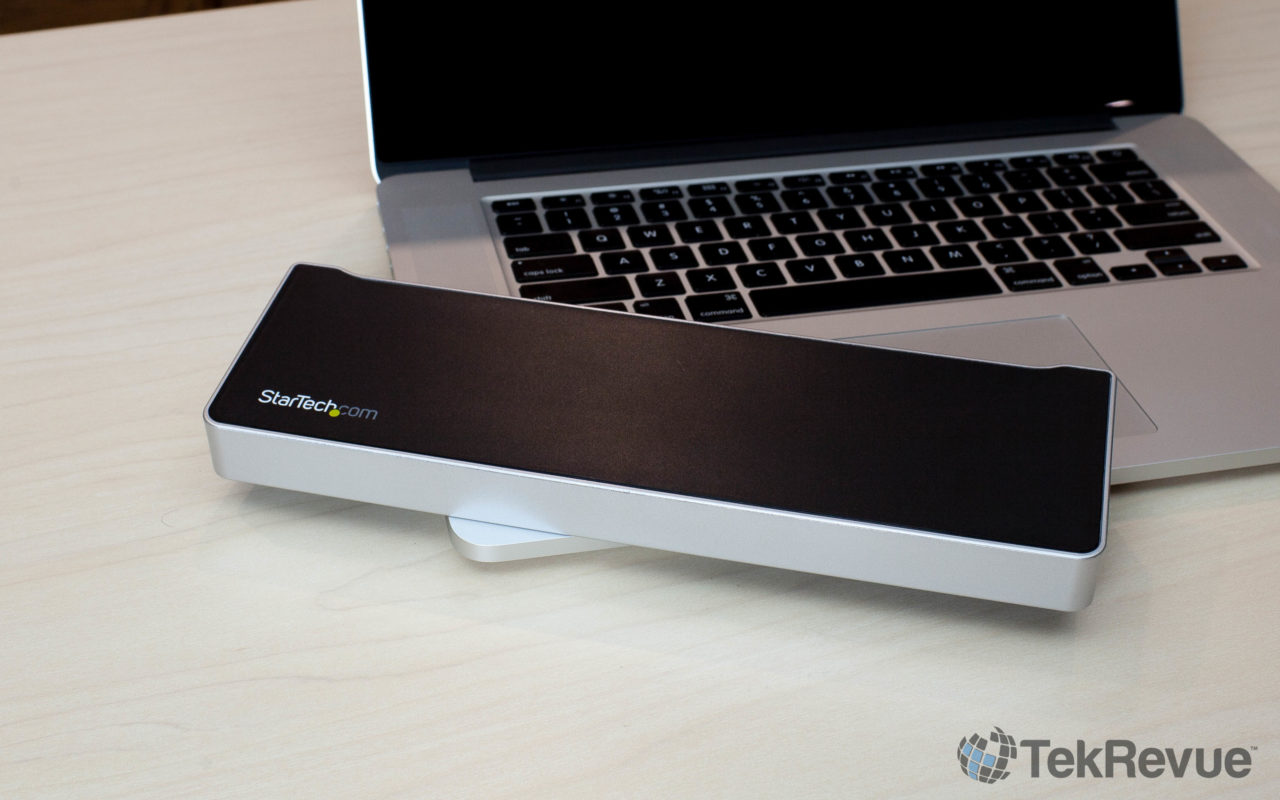




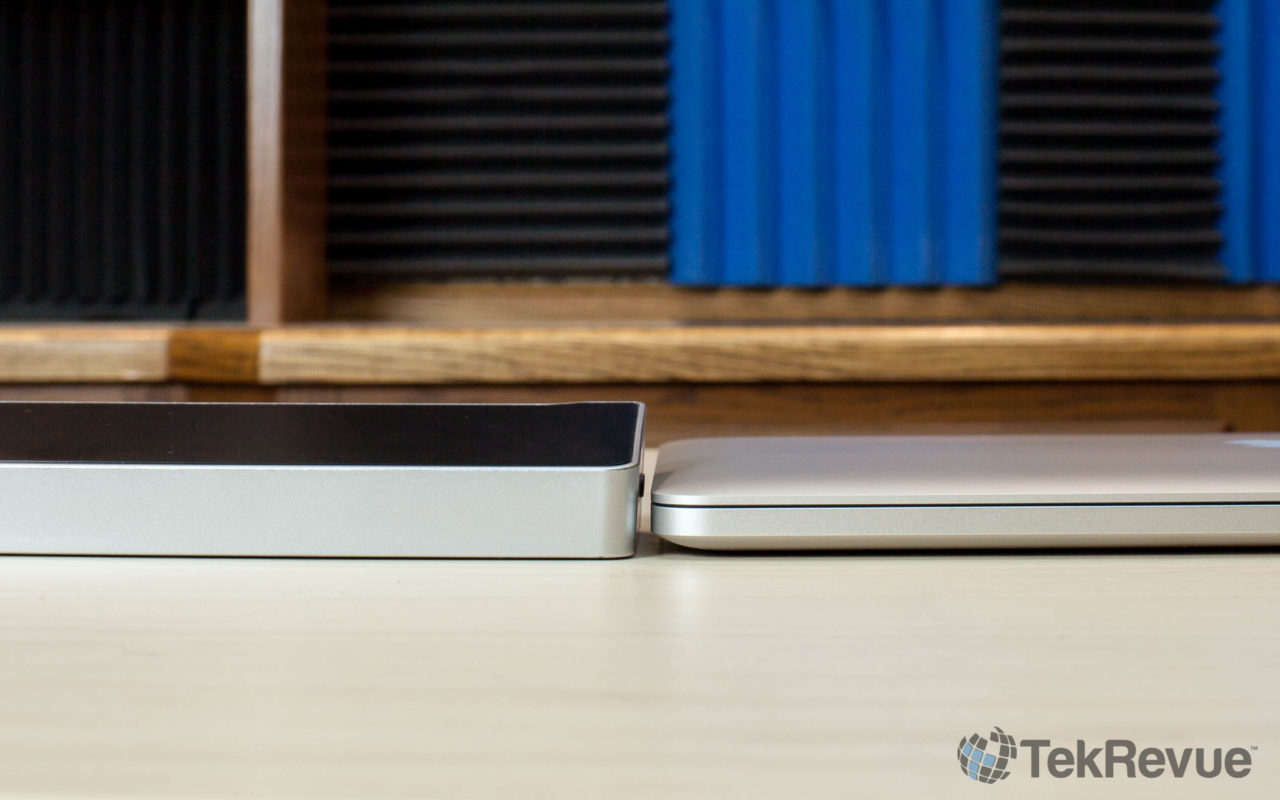
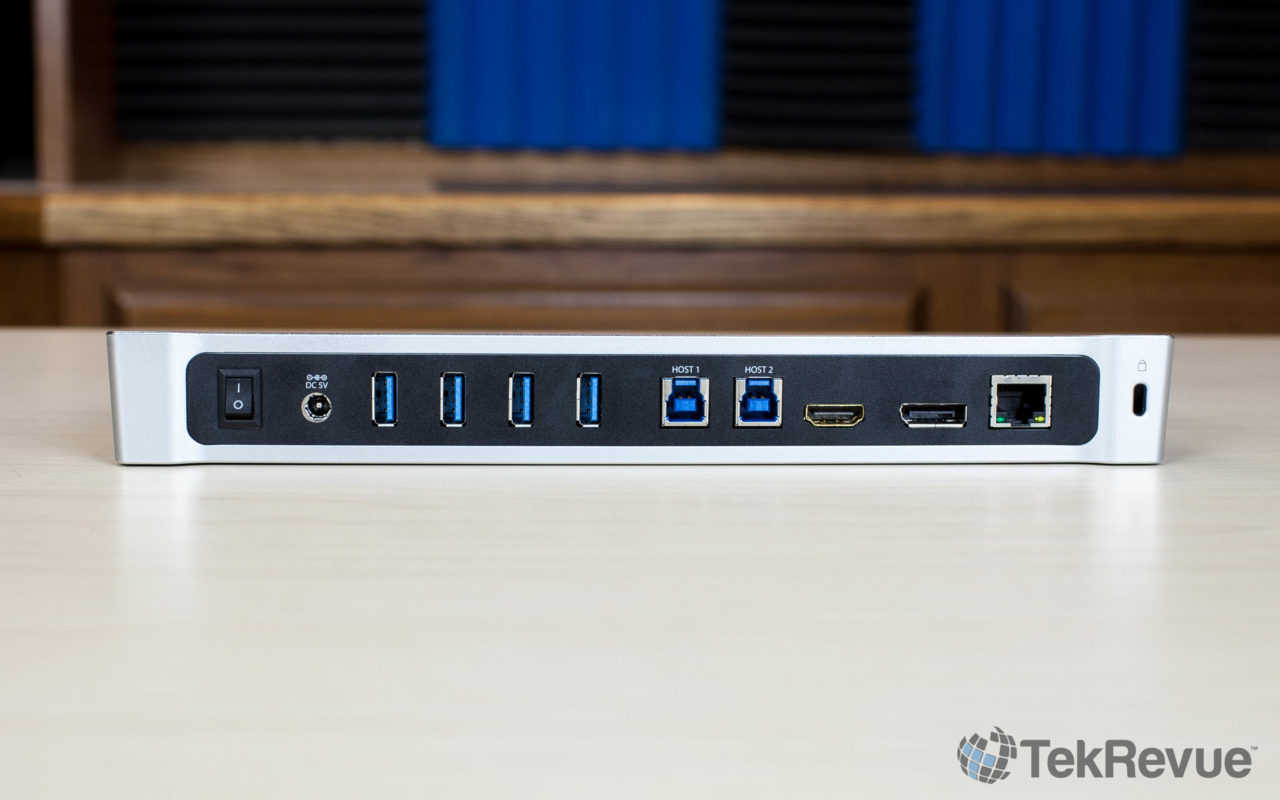
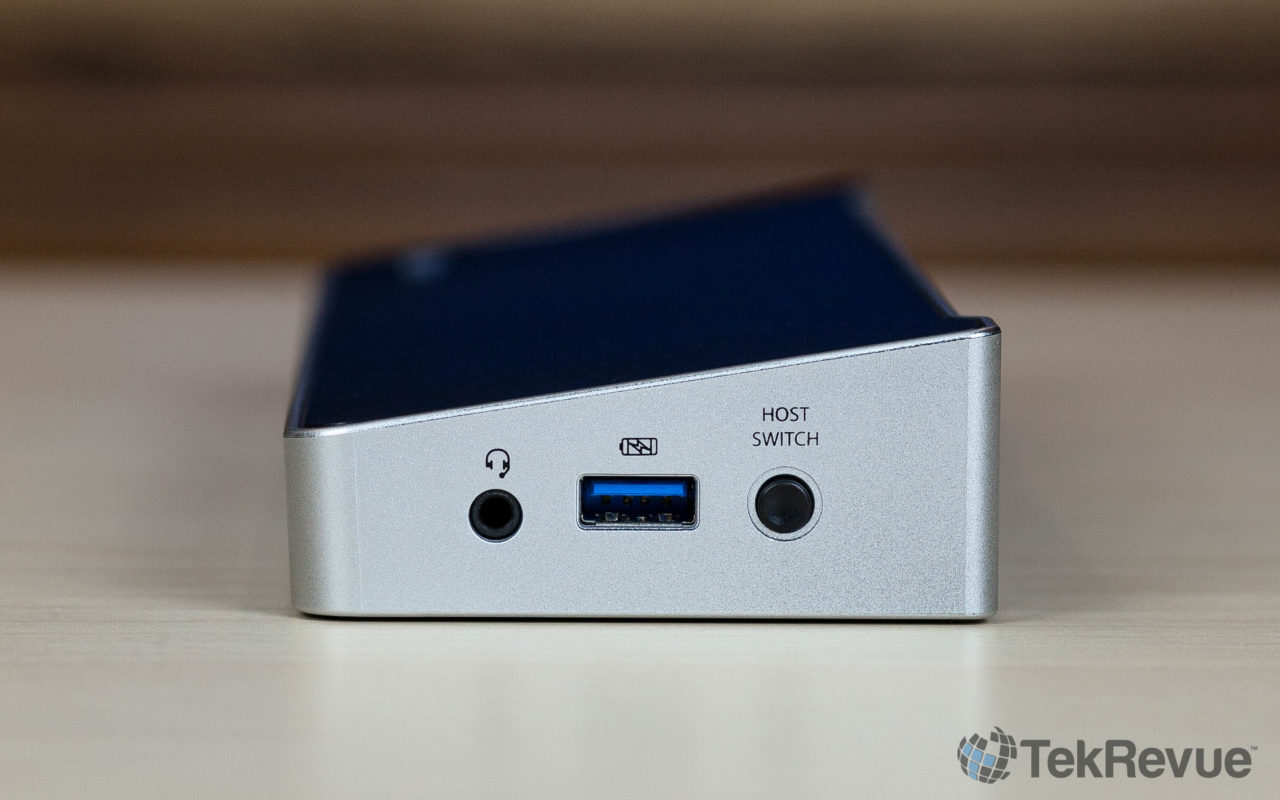
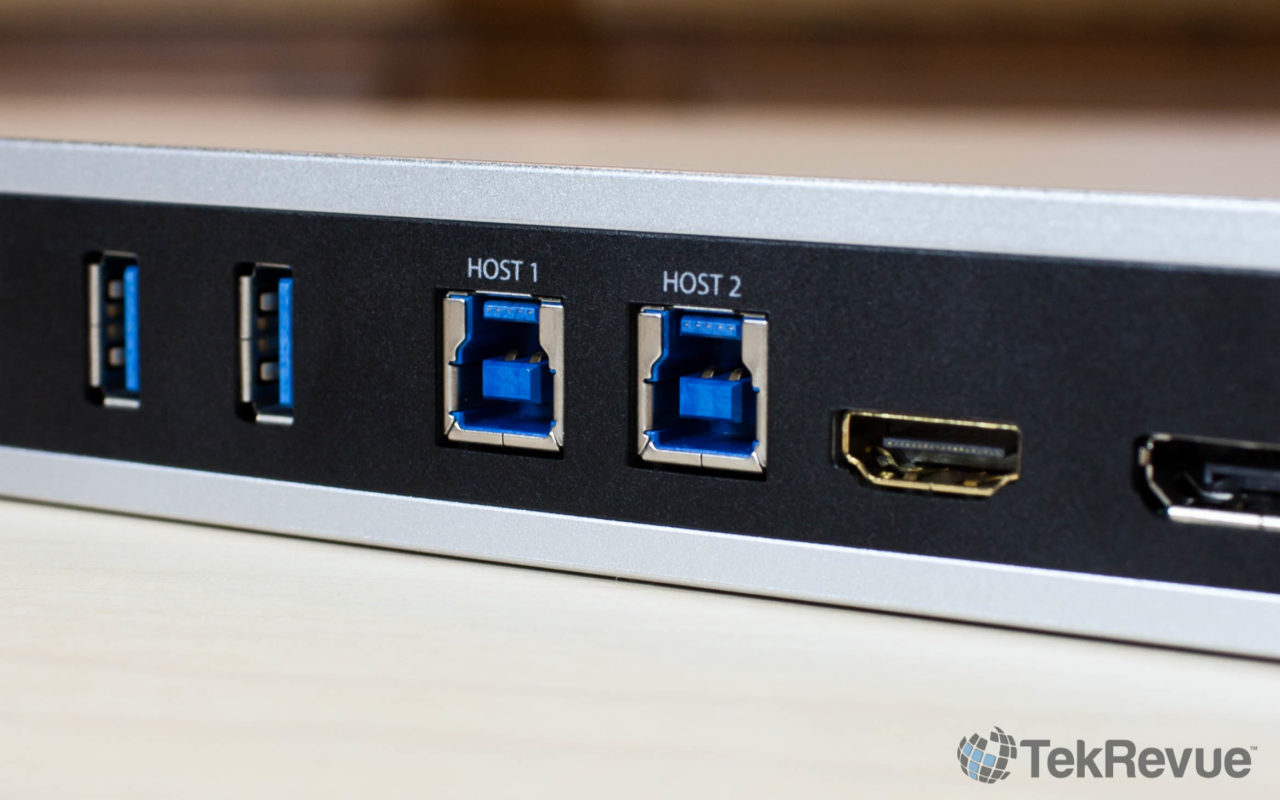
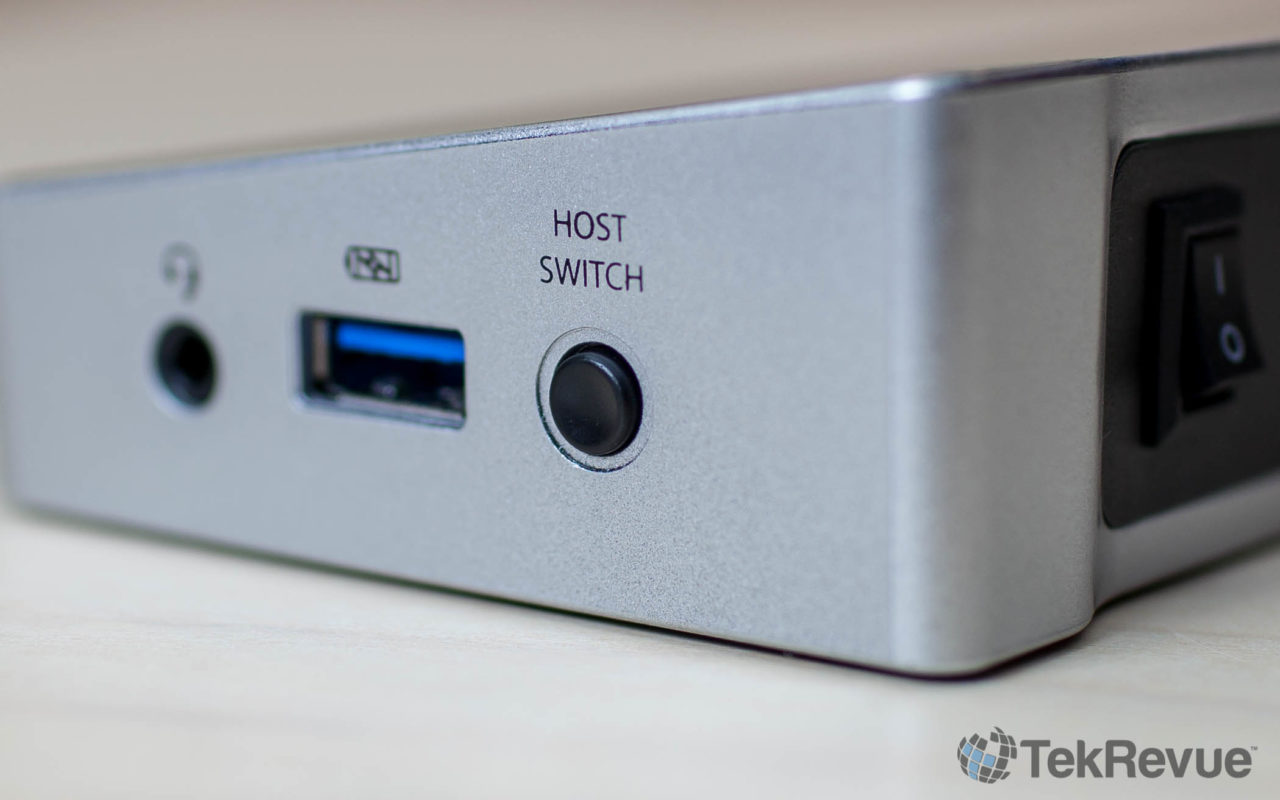
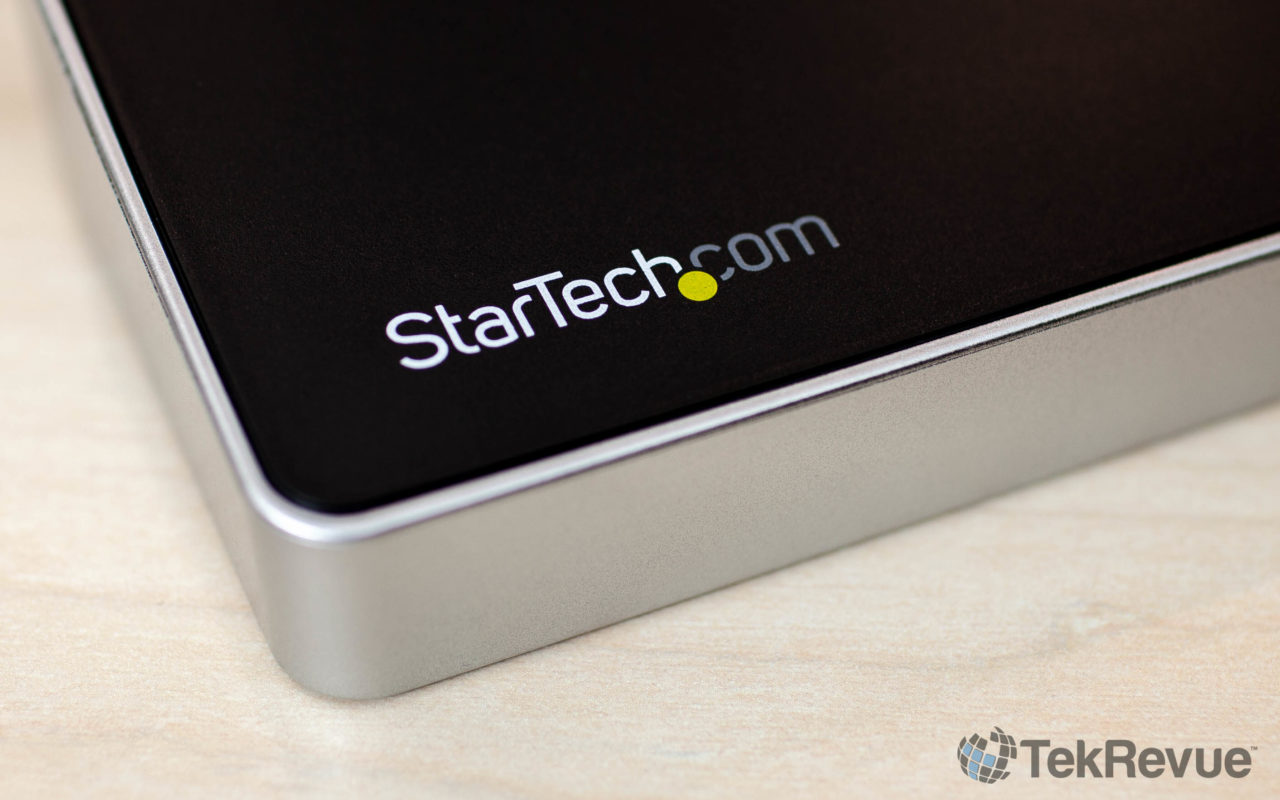













One thought on “StarTech USB 3.0 Docking Station for Two Laptops”
Can this device be used with a levovo T15 laptop in docking station – and a standard desktop computer as well ?